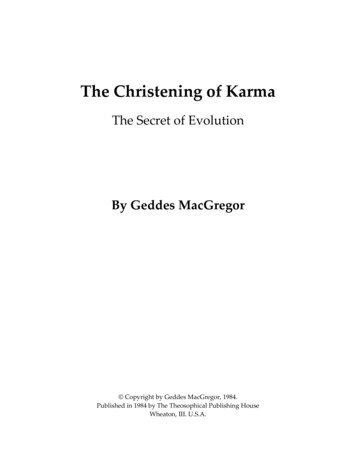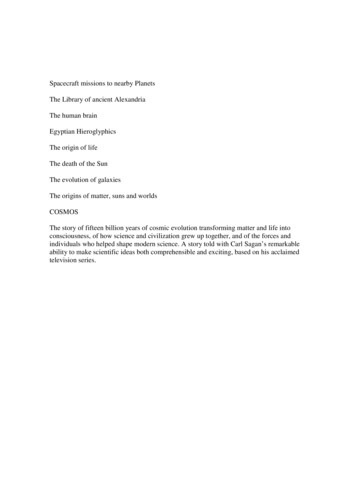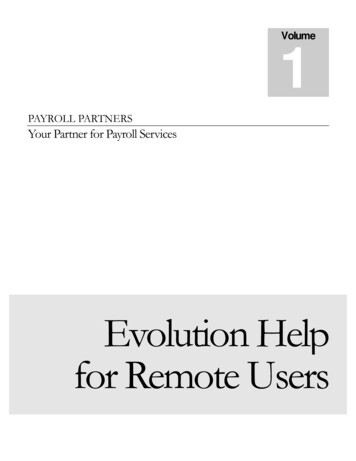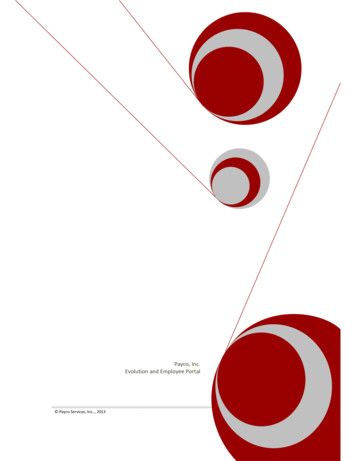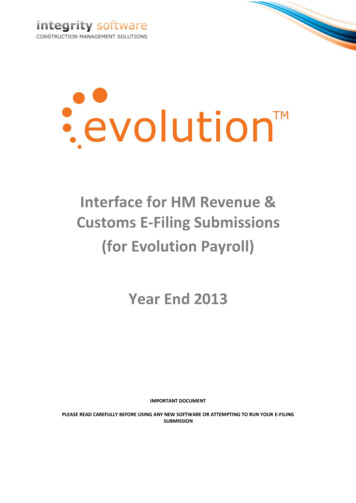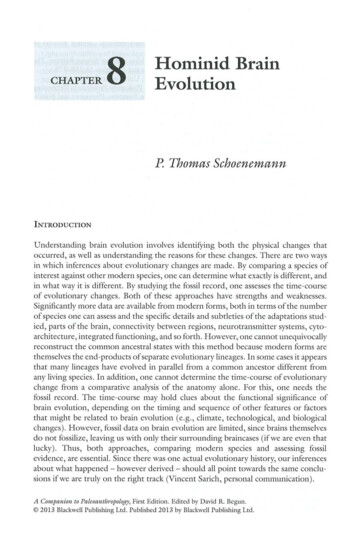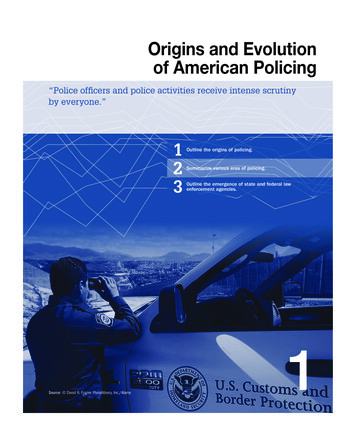
Transcription
Origins and Evolutionof American Policing“Police officers and police activities receive intense scrutinyby everyone.”123Source: David R. Frazier Photolibrary, Inc./AlamyB 10191 ch01 ptg10 hr.4c.indd 1Outline the origins of policing.Summarize various eras of policing.Outline the emergence of state and federal lawenforcement agencies.111/17/11 4:17 PM
INTROTHE EMERGENCE OF EVIDENCE-BASED POLICINGoperations. Weisburd and Neyroud call upon police leadersto correct the situation by stepping up their use of science,and by familiarizing themselves with contemporary bestpractices in law enforcement agencies around the countryand around the globe. It is essential, say the authors, todetermine what policing programs actually work, and to usethat knowledge to become wise decision-makers when asking for public moneys.“Police Science: Toward a New Paradigm,” is one of aseries of articles in the Kennedy School’s New Perspectivesin Policing series, and is available on the Web at f. It was published as part of the Kennedy School’s Executive Sessionon Policing and Public Safety, which met from 2008 to2010. An older series consisting of 17 articles, publishedbetween 1988 and 1993, comprise the original Perspectiveson Policing series, and are also available on the Web. Youcan access them at http://tinyurl.com/6b8faze.“Advance of science in policing is essential,” the KennedySchool authors wrote, “if police are to retain public supportAs you read through this text, you will learn more aboutand legitimacy.” Unfortunately, however, the authors pointevidence-based policing (see a more formal definition ofout that “evidence-based policing is [still] not the rule”the term later in this chapter) and about its relevance totoday, and that “science is [still] not an essential part ofpolicing in the twenty-first century. A good introduction to the[today’s] police world.” Worse, say Weisburd and Neyround,applicability of the modern social sciences to policing andtoday’s police leaders have failed toto the field of criminal justice in generaltake ownership of police science, DISCUSS Why do the authorscan be found in National Institute ofallowing outside institutions to dictatefeatured here say that Justice Director John Laub’s Web-basedthe nature of policing studies, and tovideo presentation entitled “Embracingproduce findings that may not even the “advance of science inA Culture of Science,” at http://nij.be relevant to day-to-day enforcement policing is In 2011, Harvard University’s John F. Kennedy School ofGovernment, in conjunction with the National Institute ofJustice, released an important new publication entitled“Police Science: Toward a New Paradigm.”1 The publications’ authors, George Mason University ProfessorDavid Weisburd and Peter Neyroud, Chief Executive ofthe National Policing Improvement Agency in the UnitedKingdom, called for “a radical reformation of the role ofscience in policing.” Their purpose was to facilitate thestart of a new era of evidence-based policing. As we shallsee in numerous places throughout this book, evidencebased policing, which refers to the use of high-qualitysocial science research to guide police practice, is rapidlybecoming an important theme in twenty-first century lawenforcement, and may be the most important innovationin policing since Sir Robert Peel formed the world’s firstmodern-day police force. The Origins of PolicingFor students of policing, an appreciation of history is essentialin order to understand the contemporary structure of lawenforcement in the United States today. As a result of historical circumstances, the American system of policing is nearlyunique in the world. Most countries today rely on one or onlya few agencies for law enforcement. In the United States, however, there are thousands of law enforcement agencies withhundreds of thousands of employees. No other country has apolicing system that looks quite like ours.The study of policing history is important for another reason: For better or for worse, history often repeats itself. Historyrepeats itself for worse when policy makers make decisions ina vacuum, without regard for those who have faced the sameproblems before. In other words, the failure to appreciate whatwas once tried without success leads to a costly repetition ofpast mistakes. Some critics of recent changes in Americanpolicing, such as the shift toward community policing, forexample, argue that what we are now doing signals a return todays of old, which may not be desirable.Alternatively, a technique or program that looks totallyinnovative and desirable today may have been purposefullyavoided in the past. An example, which we will later cover2Chapter 1B 10191 ch01 ptg10 hr.4c.indd 2The American system of policingis nearly unique in the world.more thoroughly, is federal–local law enforcement partnerships, which some see as especially important in the fightagainst terrorism. Critics of such efforts suggest that weare inching toward a national police force, a notion that,to the minds of many, is antithetical to our nation’s systemof government.History can repeat itself for the better when we revisitthe successful strategies of the past. The decentralization thatserved policing early on in our nation’s history, for example, isnow part and parcel of recent reforms in policing around thecountry.From Private to Public PolicingOne of the earliest known methods of policing, called kin policing,involved families, clans, and tribes enforcing informal rules andcustoms. Each member of the group was given authority toenforce the established rules, and individuals who deviated fromOrigins and Evolution of American Policing11/17/11 4:17 PM
community norms were oftendealt with harshly.4 This methodLEARNING Outline the origins ofof policing changed during theOUTCOMES policing.rise of the Greek city-states andthe Roman Empire, and lawGLOSSARYenforcement evolved from whatwas essentially a private affair tofrankpledge system The ultimatea public one.outgrowth of the night watch system of social control, dating to theGreece and Rome began totwelfth century, in which ten houseuse appointed magistrates toholds were grouped into a tithing,enforce the law. These unpaidand each adult male member ofindividuals were largely responthe tithing was held responsible forsible for law enforcement untilthe conduct of the others.about the third century BCEtithing Under the frankin Rome and the sixth centurypledge system, a group of tenBCE in Greece. The first paidhouseholds.law enforcement official was thepraefectus urbi, a position creparish Under the frankpledgeated in Rome about 27 BCE.5system, a group of ten tithings.By 6 CE, Rome had a largeAlso referred to as a hundred.force of these individuals whoshire Under the frankpledgepatrolled the streets day andsystem, a collection of severalnight. Once the Roman Empireparishes.fell, though, law enforcementsheriff The modern-day termbecame the responsibility of thefor the Old English shire-reeve.individual monarchies throughIn the United States today, theout Europe.senior law enforcement official inKings used military forcesa county.for law enforcement, but theyshire-reeve The Old English termalso relied on so-called nightfor sheriff. Literally, “the keeper ofwatches, or groups of citizensthe shire.”who roamed the streets lookingfor signs of trouble. Memberswatchman An early officer onfoot patrol who, during the hoursof the night watch were givenof darkness, watched for fires andthe authority to investigatecriminal activities. Upon detectingcrimes and to make arrests. Thesuch events, the watchman’s rolenight watch system eventuallywas to sound the “hue and cry” toevolved into the frankpledgeevoke a defensive response fromsystem, which became morethe citizenry. This style of policingformalizedaround the twelfthdates back to the early to midcentury when kings appointedeighteenth century in England.individuals known as chiefHenry Fielding (1707–1754) Anpledges to ensure that theEnglish magistrate who foundedsystem worked.6 In the frankwhat some have called London’spledge system, ten householdsfirst police force, the Bow Streetwere grouped into a tithing,Runners.and each adult male memberof the tithing was held responsible for the conduct of the others. Ten tithings were known asa hundred, or parish, and a group of several parishes eventuallycame to be called a shire. Shires resembled modern-day counties in terms of their size. The term sheriff comes from the oldEnglish word shire-reeve, which means“the keeper of the shire.” The shire-reevewas granted authority by the Norman kingsto levy fines against criminals and also tolevy fines against the parishes for failing tocapture criminals.1In England, the Second Statute of Westminster (1285)7required that each parish appoint two constables.8 Their dutieswere to inspect the arms of the parish and to assist the sheriff with law enforcement. Men over the age of 15 formed theposse comitatus, which assisted with the pursuit and capture ofdangerous criminals. Magistrates, who eventually came to beknown as justices of the peace, began to be appointed by the kingor the sheriff around the thirteenth century. They had primaryresponsibility for adjudicating crimes, not unlike modern-dayjudges. In England, from which we derive many of our traditions, this was the predominant model of law enforcement untilthe nineteenth century.What set early approaches to policing apart from modernpolicing practices is that most of the officials charged withenforcing laws were volunteers. If paid, they were not salariedas police officers are today. Sheriffs, for example, were allowedto appropriate a portion of the money collected in the king’sname.9 Even though these developments signaled a shift fromprivate to public policing, much of the job of enforcing the lawremained largely private; there simply were not enough publicofficials to do the job. As the years passed, though, policingtook ever greater steps in the direction of becoming a governmental function.One of the most significant steps toward fully public policing occurred in 1735, when two London parishes were givenauthority to pay their watchmen out of tax collections.10 Then,toward the middle of the eighteenth century, John and HenryFielding, two Bow Street magistrates, started to pay men toserve as constables and patrol the streets at night.11 These BowStreet Runners, or thief takers, patrolled the city on foot andthe surrounding areas on horseback. They also performedinvestigations, and for that reason they have been described asthe first known detective unit.12In 1800, the Thames River Police were paid by public moneys.13 Private police forces did not disappear, however. OutsideLondon in more rural areas, much law enforcement was still theresponsibility of churches, communities, parishes, magistrates,and a variety of other individuals. Moving beyond England,other countries also started to form public police agencies.France, Prussia (Germany), Russia, China, and India all madethe gradual shift from private to public law enforcement.14 Aspolice officers came to be paid with public funds, the shift awayfrom private policing became more apparent.The Influence of the English ModelTo a large extent, policing in London became the modelfor policing in America. Historians have called attention tovarious forces behind the emergence of American policing,several of which we will consider shortly, but what earlyAmerican policing looked like stemmed a great deal from theEnglish approach.In 1822, British home secretary SirRobert Peel criticized the state of policing inLondon. Some years later, he was responsible for passage of the “Act for Improving thePolice in and Near the Metropolis,” otherwise known as the Metropolitan Police Act.Policing in Londonbecame the model forpolicing in America.The Origins of PolicingB 10191 ch01 ptg10 hr.4c.indd 3311/17/11 4:17 PM
Adopted by Parliament in1829, this legislation createdthe world’s first large-scaleorganized police force in thecity of London.15 As othershave noted, the MetropolitanPolice Act “introduced a centralized and unified systemthief taker An alternative name forof police in England” andHenry Fielding’s Bow Street Runners.constituted a revolution inSir Robert Peel (1788–1850)traditional methods of lawA former British home secretaryenforcement.16 The legislationwhose criticisms of the state ofheralded the end of the old,policing in London led to the pasfragmented, and ineffectualsage of the Metropolitan Policesystem of parish constablesAct and the establishment of theworld’s first large-scale organizedand represented the dawn ofpolice force in that city in 1829.a whole new era of policing.17Two men, Charles RowanMetropolitan Police Act Theand Richard Mayne, werelegislation adopted by the Britishappointed to oversee develParliament in 1829 that estabopment of the force. Theylished the world’s first large-scaleorganized police force in London.adopted a military organizational model. This was resistedto a large degree by Britishcitizens out of fear that the line between policing and themilitary would be too thin, and that police might behave likeBow Street Runners An earlyEnglish police unit formed underthe leadership of Henry Fielding,magistrate of the Bow Streetregion of London. Also referred toas thief takers.2an occupying army. Rowan and Mayne, however, went to greatlengths to ensure that their officers behaved properly, and thepolice force eventually gained widespread acceptance.Sir Robert Peel’s contribution lies not just in the creation ofthe first organized police force, however. He was among the firstto envision a broader role for officers than just crime fighting.Peel emphasized the prevention of crime. He also felt that uniforms were necessary because they would make officers standout in a crowd and thus discourage crime.18 Beyond that, Peelidentified a series of principles that he said ought to characterize any police force (Figure 1.1).Policing Comes to AmericaThe first North American colonists settled along the easternseaboard. They hailed from a number of countries, includingSpain, France, Holland, Sweden, and of course England. Thefirst of these settlements, Jamestown, was established in 1607 inwhat is now Virginia. The colony at Plymouth, Massachusetts,followed, set up by the Pilgrims in 1620. Swedish and Dutchcitizens settled around what is today New York City. The Spanishclaimed land in what is now the southern United States and in theCaribbean. All of these people had visions of expanding their settlements, but given their distance from the European mainland,doing so was difficult. Expansion was particularly difficult forthe English and French because Spain’s presence was significant.1. The basic mission for which the police exist is to prevent crime and disorder.2. The ability of the police to perform their duties is dependent upon public approval of police actions.3. Police must secure the willing cooperation of the public in voluntary observance of the law to beable to secure and maintain the respect of the public.4. The degree of cooperation of the public that can be secured diminishes proportionately to thenecessity of the use of physical force.5. Police seek and preserve public favor not by catering to public opinion but by constantlydemonstrating absolute impartial service to the law.Sir Robert Peel’sNine Principlesof PolicingFIGURE 1.16. Police use physical force to the extent necessary to secure observance of the law or to restore orderonly when the exercise of persuasion, advice, and warning is found to be insufficient.Sir Robert Peel’s NinePrinciples of Policing.Source: J. L. Lyman, “TheMetropolitan Police Act of 1829: Ananalysis of certain events influencingthe passage and character of theMetropolitan Police Act in England,”Journal of Criminal Law, Criminology,and Police Science, vol. 55, no. 1(March 1964): 141–54.4Chapter 1B 10191 ch01 ptg10 hr.4c.indd 47. Police, at all times, should maintain a relationship with the public that gives reality to the historictradition that the police are the public and the public are the police; the police being only membersof the public who are paid to give full-time attention to duties which are incumbent on every citizenin the interests of community welfare and existence.8. Police should always direct their action strictly toward their functions and never appear to usurp thepowers of the judiciary.9. The test of police efficiency is the absence of crime and disorder, not the visible evidence of policeaction in dealing with it.Origins and Evolution of American Policing11/17/11 4:17 PM
Earlyon,churchesin America were heavilyinvolved in crime control,though without a formalcriminal justice system.People who strayed fromacceptable forms of conductwere often shunned by theircongregations. According toone historian, church congregations functioned as the“police and courts of firstresort.”19 Moreover, when corporal punishments were used,they were often carried out inpublic. The use of stocks, floggings in the public square, andeven public hangings were common methods of dealing withwayward individuals. Public punishments, often witnessed byhundreds of people, made clear to everyone the consequencesof inappropriate behavior.As more colonists moved to the New World, however, they“brought the law in their baggage.”20 That is, they broughtknowledge of English criminal codes, law enforcement agencies, and methods of punishment, and they adapted them toserve the needs of their new communities.Chaos in the CitiesAs America came of age, more immigrants arrived andsettled in urban areas. Cities became increasingly crowded,dangerous, and dirty. For example, from 1850 to about 1880,New York City’s population grew until almost a million people were crowded into the two-square-mile center of the city.The city’s East Side housed nearly 300,000 people who lackedtoilet facilities, heat, fire protection, and other essentials.Unemployment levels were high, and sickness abounded.Cholera outbreaks were common, killing thousands of peopleat a time.By the mid-1800s, crime had become commonplacethroughout many American cities. People stole and lootedto survive. Organized gangs formed, fought for territory, andcontributed to the violence and mayhem within the city. By oneaccount, by 1850 New York City had become America’s mostterrifying city.21 Other large cities like Boston, Chicago, andPhiladelphia hardly fared better.Early efforts to control crime fell on the shoulders ofappointed constables and citizen volunteers. The constablespatrolled during the daytime; citizens patrolled at night. But asthe cities grew and became more dangerous, this system couldnot keep pace with crime.22 In 1844, the first metropolitan policedepartment was formed in the New York City area. It initiallypatrolled only during the daylight hours, leaving the preexisting night watch to patrol the city during darkness. The earlyNew York City force was modeled after London’s MetropolitanPolice and consisted of only 16 officers appointed by themayor.23 The force was reorganized and expanded to 800 officers in 1845 under Mayor William Havemeyer, who divided thecity into three police districts. This period also saw the elimination of the old night watch system and the construction ofstation houses and local courts.24 Twelve years later, in 1857,the police in Manhattan, Brooklyn, Staten Island, WestchesterCounty, and the Bronx were consolidated into one department under a governor-appointed board of commissioners,becoming what we think of today as the New York CityPolice Department (NYPD).25 Prior to the consolidation,18 separate police forces patrolled within the area that comprises present-day New York City.26 Some of them were betterequipped and organized than others. Lacking, however, wasa centralized police mandate, good communications, andcoordinated efforts.27On the one hand, the combined force of 1857, which initially consisted of 6,396 members, was welcomed by peoplewho were distressed about problems of social disorganizationand crime within the city. On the other hand, there was concern that the new police force might become a standing army(recall that our nation was founded, in part, out of frustrationwith overreaching, centralized government).28 Other large cities quickly followed the New York example, establishing theirown police forces. They did soin response to surges in viobobby The popular British namelence, conflict, multiple riots, given to a member of Sir Robertand citizen fears that America’s Peel’s Metropolitan Police Force.3experiment in self-governanceTexas Rangers A militia originallymight not survive.formed by Stephen F. Austin inLondon’s police, as we 1823 to protect the territory ofhave already seen, served asTexas against Native Americansomething of a model for polic- raids, criminals, and intruders.ing in many American cities.Today, the Rangers serve asReformers in America were part of the Texas Department ofimpressed with what London’s Public Safety.bobbies did to prevent, andslave patrol A crude form ofnot just respond to, crime.29private policing, often carried outLondon’s police stressed highly by citizen volunteers. Slave patrolsvisible patrols intended to dis- were created in the eighteenth cencourage crime. But the police tury to apprehend runaway slavesforces of New York and other and to ensure that slaves did notrise up against their owners.large cities differed fromtheir English counterparts in due process of law A rightat least two important ways. guaranteed by the Fifth, Sixth,First, unlike police in London,and Fourteenth Amendments andAmerica’s first police officers generally understood, in legal contexts, to mean the due course ofwere heavily involved in politics.30 Most police officers at the legal proceedings according to therules and forms established for thetime answered to political leadprotection of individual rights. Iners or ward bosses in the areasthey served. Officers’ very jobs criminal proceedings, due processof law is generally understood towere dependent on remaininginclude the following basic elein the good favor of whateverments: a law creating and definingpolitical figure was in chargethe offense, an impartial tribunalat the time. Second, in starkhaving jurisdictional authority overcontrast to their counterparts the case, accusation in properin London, American police form, notice and opportunity todefend, trial according to estabofficers were more willing touse force.31 These two unique lished procedure, and dischargefeatures of American policing from all restraints or obligationscontributed in no small part to unless convicted.policing as it is known today.The Origins of PolicingB 10191 ch01 ptg10 hr.4c.indd 5511/17/11 4:17 PM
TIMELINEHistorical Eras in American Policing1840s–19301930–1970sPolitical Era Close ties between the police and political officialsReform Era Police gained pride in their professionPolice were organized in paramilitarystyle, focused on serving thepolitically powerfulLaw enforcement focused on “traditional”crime-fighting and the capture of criminalsCrackdown on organized crimePoliticians appointed/hired the policeCame about because of a need forsocial order and security in adynamic and rapidly changing societySource: SuperStock, Inc.Progressive policing policy led by August Vollmer and O.W. WilsonCame about because citizens called for reform and the removal of politicsfrom policingSource: Image AssetManagement Ltd./SuperStock, Inc.Source: Schmalleger, Frank J., CRIMINAL JUSTICE: A BRIEF INSTRUCTION, 9th Edition, 2012. Reprinted by permission of Pearson Education, Inc., Upper Saddle River, NJ.Frontier communities oftenformed their own possesand vigilante citizen groups.The Move WestAs American pioneers moved westward, they did not leave the problems of the cities behind. In fact,the frontier mentality of fendingfor oneself and providing one’s ownself-protection fueled plenty of violence. Guns, knives, andfists were commonly used to resolve disputes in newly settledareas. Sheriffs and their marshals were appointed by townleaders to provide what little law enforcement was available onthe frontier. These officials’ authority, though, was not alwayswelcomed or respected. Theirs was a lonely and dangerous job,and they repeatedly became the targets of outlaws. Makingmatters even more difficult, prominent outlaws of the day,including Billy the Kid and Jesse James, were apparently idolized as much, if not more, than the sheriffs and marshals themselves. Law enforcement was, at best, unreliable; at worst, it wasnonexistent. Indeed, some of the new “lawmen” worked bothsides of the law, depending on which side offered them thebest opportunities and rewards. Consequently, frontier communities often formed their own posses and vigilante citizengroups to confront any person or group intent on disruptingsocial stability.32Even these efforts eventually failed, despite support fromthe community. Not unlike what happened in the big cities, once populations in the West grew, something more wasneeded. It was inevitable that the kinds of agencies formedalong the eastern seaboard would be replicated in citiesHeavily involved in politicsMore willing to use forcethroughout the West. An examplewas Stephen Austin’s corps of fighters, a group of tough men he enlistedto protect the settlers he was bringing into the Tejas, Mexico, area. Thiscorps of rangers eventually aided inthe Texas revolution against Mexico, providing scout servicesfor the U.S. Army during the Mexican-American War. Theycame to be known as the Texas Rangers, and their effortsushered in a period of enhanced border patrol in Arizona andNew Mexico as well as the formation of state police forcesthroughout the Southwest.33Organized police forces in early America were born ofnecessity. A single law enforcement official rapidly becameinadequate as populations surged. Densely populated cities could not realistically be patrolled with one or even afew officers. But unlike the evolution of policing in othernations, Americans rejected centralized power and shunnedany national police force. Law enforcement became a localeffort that reflected local priorities and issues. That is why todaywe see thousands of distinct police agencies at various levels ofgovernment all across the United States. Even if there had beena desire during this period for a centralized police agency, it isdoubtful it could have succeeded, given the size of the territoryfor which it would have been responsible. Early police agenciescould not have survived without some connection to the communities they patrolled.This decentralized policing model (which is discussed inmore detail in Chapter 3) has been hailed as representing theAmerican ideal, but there was a downside. As police agencies proliferated across America, they varied widely in termsof quality and professional commitment. Some may arguethat policing today is not as highly regarded an occupationas it could be, but in the late nineteenth century, policingwas generally viewed as routine, unglamorous work. Officerswere held in low regard and, because the pay was poor, citieshad difficulty recruiting qualified candidates. So desperateOrganized police forces in earlyAmerica were born of necessity.6Chapter 1B 10191 ch01 ptg10 hr.4c.indd 6Origins and Evolution of American Policing11/17/11 4:17 PM
2001–TodayCommunity Era Police departments work toidentify and serve the needs of their communitiesThe New Era Policing to secure thehomeland; emphasis on terrorismprevention and intelligence-led policingEnvisions a partnership between the police andthe communityBuilds on partnership with the community to gather intelligencePolice focus on quality-of-life offensesCreation of counterterrorism divisions and offices within policedepartments and the development of actionable intelligenceBroken windows model of policingSource: UpperCut Images/Superstock Royalty FreeCame about because of a realization that effectivecommunity partnerships can help prevent and solve crimeswere some cities to hire police officers that, as one historianobserved, “illiteracy, poor health, chronic drunkenness, or acriminal record were no barriers to a job as a police officer.”34Pressure for agencies to grow, combined with close relationships between the police and politicians and others in positionsof influence, resulted in poor quality police work. What’s worseis that a commitment to crime control and community servicewas secondary. Nonetheless, this period of politics and ineptitude has been described as the first significant era of policingin America.Policing the SlavesUnique circumstances existed in the American South during thisearly period. There, slave patrols represented a crude form ofpolicing. Slave patrols were created in the eighteenth century toapprehend runaway slaves and to ensure that slaves did not riseup against their owners. The slave patrols were largely a privateactivity carried out by citizen volunteers, leading to a serious lackof control of the slave patrols’ actions. When they apprehendedrunaway slaves, they often meted out “justice” on the spot, frequently using violence.Due process of law was a distant concern. Slave patrolscould (and did) arbitrarily enter private residences for the purpose of rounding up those who fled from bondage. The patrolswere largely an outgrowth of fear on the part of wealthy whitelandowners that slaves were a dangerous group in need of careful scrutiny and control. With the end of the Civil War camethe dissolution of the slave patrols. They did, however, providethe impetus for the Ku Klux Klan, whose mission of terrorizing(Source:P-59 Photos/Alamy Images1970s–2001Came about because of the terrorist attacks of September 11, 2001,and ongoing threats to the safet
see in numerous places throughout this book, evidence-based policing, which refers to the use of high-quality social science research to guide police practice, is rapidly becoming an important theme in twenty-first century law enforcement, and may be the most important innovation . that knowledge to become wise decision-makers when ask-ing .
